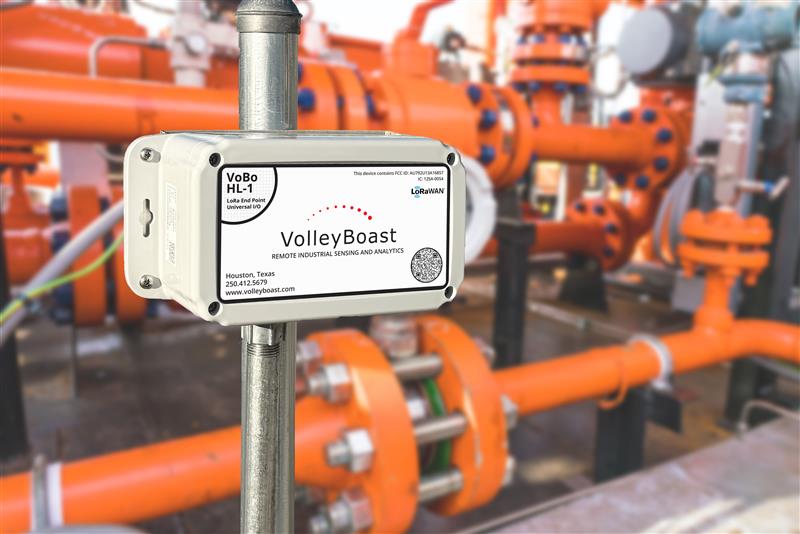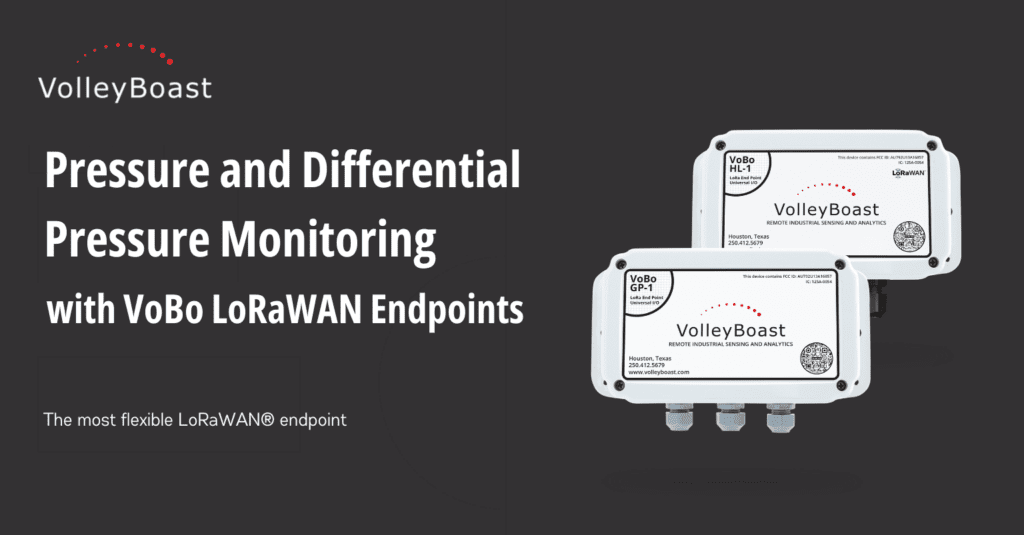For many industries, pressure and differential pressure monitoring are essential for maintaining system efficiency and safety. The VoBo is an excellent choice for pressure and differential pressure monitoring with its long-range and low-power wireless connectivity.
The VoBo endpoint is agnostic to the pressure transmitter being used. This makes the VoBo the ideal LoRaWAN® bridge endpoint for pressure and differential pressure monitoring.
This article explores the fundamentals of pressure monitoring and how the VoBo with VoBoAnalytics and VoBoSync provides accurate real-time pressure measurements for any industry.
Fundamentals of Pressure and Differential Pressure Monitoring
Pressure and differential pressure (DP) monitoring is important for many industries that handle liquids and gases. Here’s a look at the fundamentals.
Pressure Monitoring
Pressure is the force exerted by a fluid (liquid or gas) against a surface. This is measured in units such as Pascals (Pa) or pounds per square inch (psi). The actual pressure measurement involves detecting the force that’s exerted by the gases or liquids.
Applications include:
- Process automation – Using pressure to regulate pressure control loops in industrial systems
- Pipeline management – Analyzing the fluid pressure and detecting leaks
- Reliability – Monitoring the pressure in a system to determine when maintenance is required
- Water and gas – Monitoring the pressure variances in distribution systems
- HVAC (Heating, Ventilation, and Air Conditioning) – Balancing air and pressure
- Automotive and aerospace – Improving performance with high-resolution pressure sensing
Differential Pressure (DP) Monitoring
Differential pressure is the difference in pressure between two points in a system. This is often used to determine the flow rate, filter status, or liquid level. It is measured across two points by a differential pressure sensor or two separate pressure sensors.
This technique is used for:
- Flow rate calculations – Measuring the pressure drop across a restriction
- Condition monitoring – Using pressure to indicate equipment condition in industrial systems
- Liquid level measurement – Hydrostatic DP monitoring in sealed tanks
- Safety and diagnostics – Identifying leaks and blockages
Using a VoBo for Pressure Monitoring

A VoBo endpoint works with pressure monitoring systems by bridging the pressure sensors and the industrial networks.
Key features of VoBo endpoints:
- Wireless LoRaWAN® Connectivity – The internal antenna has a range up to 6 miles LOS (Line of Sight) and works well in congested industrial plants
- Multiple I/O Support – Interfaces with analog (4-20mA, 0-5V, 0-10V), digital (dry contact and voltage), digital interrupt (dry contact wake-up), and serial (RS485 Modbus RTU).
- Seamless Industrial Integration – Deploy VoBo endpoints at scale with LoRaWAN®.
- Rugged Industrial Design – IP66/NEMA 4X-rated enclosures ensure reliability in extreme weather and industrial environments.
- Hazardous Area Ready – VoBos are available with Class 1, Division 2 hazardous area certification.
- Remote Configuration – VoBo configuration changes can be made by downlink over-the-air.
- Battery Power – Battery-powered VoBos can power sensors for years.
- VoBoAnalytics – Optional onboard processing can provide additional insight into the data
- VoBoSync – Optional tool to sync a group of VoBos to take measurements at the same or coordinated times, improving the value of the data set.
VoBoAnalytics Increases Pressure Monitoring Options
VoBoAnalytics extends a VoBo’s capabilities beyond data collection by adding sensor data analysis and the ability to transmit the analyzed results with or in place of the collected data. This provides additional functionality in pressure monitoring systems.
Features include:
- Blockage Monitoring – Detect DP increases due to blockage, prompting alerts for maintenance.
- Dynamic Configuration – Adjust the VoBo measurement frequency when a sensor reading crosses a preset threshold.
- Modbus Analysis – The VoBo can read, decode, and run analytics on data collected via Modbus.
- Relay Control (VoBo XP Models) – Energize or de-energize a relay based on the observed pressure conditions.
- Custom Algorithms – Simple or complex calculations can be applied to measurement data, including maximum, minimum, average, mode, standard deviation, and rate-of-change.
VoBoSync Increases the Power of VoBo for Facility-Wide Pressure Monitoring
VoBoSync synchronizes multiple VoBo endpoints in a group to take sensor measurements from multiple locations at the same time or at a scheduled time. It can also improve the quality of differential pressure analysis between VoBos. This is great for applications that require pressure measurements across multiple points in a system. Features include:
- Synchronized Measurements – VoBoSync coordinates the exact timing of sensor data collection across all enabled devices. This ensures that all measurements are taken at the same time at scheduled intervals. This is crucial for situations where the timing of the data capture impacts the analysis.
- Optimized Data Transmission – By synchronizing the data transmission schedules, VoBoSync minimizes the risk of data packet collisions within the LoRaWAN® network. This reduces the need for retransmissions, which conserves bandwidth and extends battery life.
- Enhanced Data Insight – Synchronized data collection improves the relevance of the data, which provides more reliable insights and supports more informed decision-making.
Applications of Differential Pressure Measurement with VoBo
There are many ways to use a VoBo in pressure monitoring systems. Here’s a look at a few popular applications.
Blockage Monitoring
A rising differential pressure can indicate a blockage or restriction in the system, and corrective actions are needed. An accumulation of particles over time or degraded equipment condition can be identified by an analysis of pressure data. A VoBo can collect the pressure data needed to detect these changes and signals when maintenance is needed.
Clean Room Control
In pharmaceuticals, biotech, and semiconductor manufacturing, it’s important to maintain a positive pressure to prevent contamination. A VoBo provides differential pressure monitoring to ensure that positive pressure is maintained.
Flow Measurement
Measuring the pressure drop across a restriction (like a pipe or valve) can indicate the flow rate. A VoBo determines the flow rate by measuring the differential pressure drop across a restriction in a pipe with a differential pressure sensor or two separate sensors
HVAC Optimization
Differential pressure monitoring in HVAC systems helps optimize the airflow. This identifies problems in the ductwork and leads to improved energy efficiency.
Safety and Leak Detection
Sudden changes in differential pressure can indicate leaks in a system. A pressure sensor connected to a VoBo identifies abnormal pressure drops. This identifies potential pipeline leaks, blockages, or system failures that will need maintenance or immediate attention.
Liquid Level Measurement
In tanks, pressure can be used to determine the liquid level. A VoBo can report pressure data taken in a fluid column by a tank level pressure sensor at the bottom of the tank or use two pressure sensors at different heights in the fluid column to calculate liquid level.
Primary Flow Element Measurement
Using pressure sensors with orifice plates, Venturi tubes, or nozzles, a VoBo can provide the data needed to determine flow rates by applying differential pressure calculations.
System Control and Optimization
Monitoring system pressures provides the data needed to maintain the ideal operating conditions in all types of industrial systems.
Conclusion
VoBo bridge endpoints, VoBoAnalytics, and VoBoSync provide a cost-effective and powerful solution for industrial monitoring and automation. They provide secure, reliable communication and low-power operation. This makes them ideal for LoRaWAN®-based pressure and differential pressure monitoring systems.
Purchase a VoBo on our website. Corporate accounts and integrators: please contact us at info@volleyboast.com or +1 250-412-5679.

